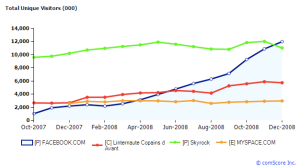 This post is part of my social media 101 primer series. If you haven’t done so, you might want to read my previous post Social Media: What’s on Top?. This time I’m presenting the hot and cool social media services that didn’t make the Top 20 but still are worth mentioning.
This post is part of my social media 101 primer series. If you haven’t done so, you might want to read my previous post Social Media: What’s on Top?. This time I’m presenting the hot and cool social media services that didn’t make the Top 20 but still are worth mentioning.
The game changers
My objective for this post is to point at some social media services that in my opinion have a great potential of disrupting or invalidating long-established business models of media companies. And, by the way, here is why every company is a media company. By no means this list could ever be complete. Forgive me for not mentioning this or that great service (but please, leave your comment below). I’m making my selection based on personal, hands-on experience. Don’t focus on the brands – I need to give you examples. But what’s most important is the concept behind them.
Google Reader is an online RSS feed reader – yawn! While it doesn’t sound very sexy, it virtually made me quit browsing newspaper’s websites altogether (now you know where I’m heading, don’t you). Right now almost any source of information on the Web offers you the opportunity to subscribe to their RSS feed. And your RSS reader just keeps your reading list right there, neatly ordered, ready for you waiting for your spare 10 minutes between meeting and conference call. Because over time you are getting picky about your information sources, you end up with tens or even hundreds of feeds linked to blogs that are updated not very often but with very valuable content. You can fine-tune your selection of feeds to your particular needs. Want to learn more about RSS? Check this flick out.
Google News is a news syndication/aggregation service. Using powerful Google Web indexation technology it scans the news sources around the globe, groups stories referring to the same topic together and allows you to filter the categories according to your personalized interest. What you get is your personalized newspaper fed by headline stories from all over the world. You can guess – Google owns or licenses very little content themselves – that’s why you are presented only with the title and the lead of each article – to read the full story you need to click through to the original site. Looks like Google is doing the newspapers a favor, right? Think again. Skimming through the title and the first paragraph is enough to skip the news and go to the next one. Try it yourself. That is why Google got sued by a number of publishers and we know they settled with AFP. And you know that already – you can grab your personalized RSS feed from Google News and plug it into your RSS reader. This way you have a single reading list consisting of all your hand-picked high-value blogs and personalized world and local news. You can imagine now what should happen to the online traffic (and advertising revenue) of the newspapers. They call it signs of secular change.
Update: ZDNet ranks Google News as the 5th most popular news site in Feb 2009, trailing Yahoo! News, The Weather Channel, CNN and MSNBC.
Twitter is a social network built around a micro-blogging service. Sounds flat? OK, rollback. Twitter is a paradigm shifter – in my opinion it has the potential to add yet another dimension to the way people communicate. Much like SMS did for cell phones, but being deeply rooted in online social networking it has enormous integration opportunities. The number of users right now is estimated around 5 million and growing rapidly. One can’t explain what Twitter is in a few words but here is an excellent explanation and a video. But I must warn you: I had been reading stories about Twitter long time before I joined and wasn’t impressed. You really need to try it out and getting comfortable will take you a few days. Make sure you read this fantastic non-fanatical beginners guide to Twitter first. And another warning: it’s addictive. There is zillion and one applications for Twitter now and twice as much undiscovered yet. But let me focus on just one simple characteristics: many people post updates on what interesting articles they have just written or found on the Net. If your choice to follow people on Twitter is based on their interests being similar to yours, you get the most up-to-date, fine-tuned-to-your-needs news service you can dream of. It is filtered by the collective wisdom of the individuals you have chosen to trust.
Digg is a social bookmarking site with 30 million users. Once you get your hands on an interesting piece of news through whatever means, you might want to bookmark it for future reference. Sure you can use your browser’s bookmark feature but there are reasons to keep them on the Web instead. Digg is my personal preference, but there are other services. The ‘social’ part of Digg is that all bookmarks are public – you can submit the story or bookmark (or ‘digg’) the story submitted by somebody else. By digging the story you increment its digg counter, which indicates how popular the story is. But the coolest part of Digg is the Upcoming tab. In order to create this page for you, Digg tries to understand your interest profile based on what you’ve dugg before and to match it with the profiles of other users. The Upcoming tab then displays the stories freshly submitted by those users whose profiles are similar to yours. And, of course, you can friend people on Digg and get Friends’ Activity stream. You know that already – sure, there is Friends RSS feed and that’s how we’ve closed the circle back to the RSS reader.
Back in the old days we used to jump from website to website trying to find the information or we used search engines to find content about the topic of interest. In the process we were generating ad displays which converted into revenue streams for the content owners. The tools described in my previous article enabled massive proliferation of user-generated content. With the services presented above our position vis-a-vis the content on the Web has changed. We are no longer running around searching for information. The information comes to us thanks to collective effort of other people.
The Human-Powered Search
Now we’ve got to the point where we don’t need to spend our valuable time on searching and filtering relevant information from irrelevant hype. This doesn’t mean that the amount of information flow gets automatically reduced to a manageable level, but that is a different story. We will still need search and recommendation engine but it is going to be quite different from what we know now. There are two interesting posts that helped me organize my thoughts around it (came by Twitter, by the way): Google’s First Real Threat? Twitter and Is the real-time web a threat to Google search?. “My web is my network” as @newtonmota has just succintly put it. Or in other words, the content that is interesting for me is defined by the people whom I trust, through some form of expression of their interest in it (be it tweet, digg, comment, etc.). This subtle network of connections cannot be replaced by any automatic indexing and ranking algorithm which does not have access to this network. In case you missed it – for that very reason Facebook has just introduced the “I like this” feature in their platform.
How the commercial content provider can play a role this game? Leave your comments and stay tuned for my take on the future trends in social media. Real-time web and more is coming soon.
![]() As you might have heard, there is a new application coming out of Google Labs, called Fast Flip. I’m not going to explain what it does, go and see for yourself. But I got exactly this question in my Facebook News Feed. So, here is what I think:
As you might have heard, there is a new application coming out of Google Labs, called Fast Flip. I’m not going to explain what it does, go and see for yourself. But I got exactly this question in my Facebook News Feed. So, here is what I think:
 More often than not, today’s news from traditional publishing industries bring the picture of a hapless dodo bird in front of my eyes. No surprise there – difficult economic times usually expedite the natural selection process.
More often than not, today’s news from traditional publishing industries bring the picture of a hapless dodo bird in front of my eyes. No surprise there – difficult economic times usually expedite the natural selection process.  Yesterday
Yesterday 

 Yesterday I read
Yesterday I read  Today I read the
Today I read the 
 This post is part of my social media 101 primer series. If you haven’t done so, you might want to read my previous post
This post is part of my social media 101 primer series. If you haven’t done so, you might want to read my previous post